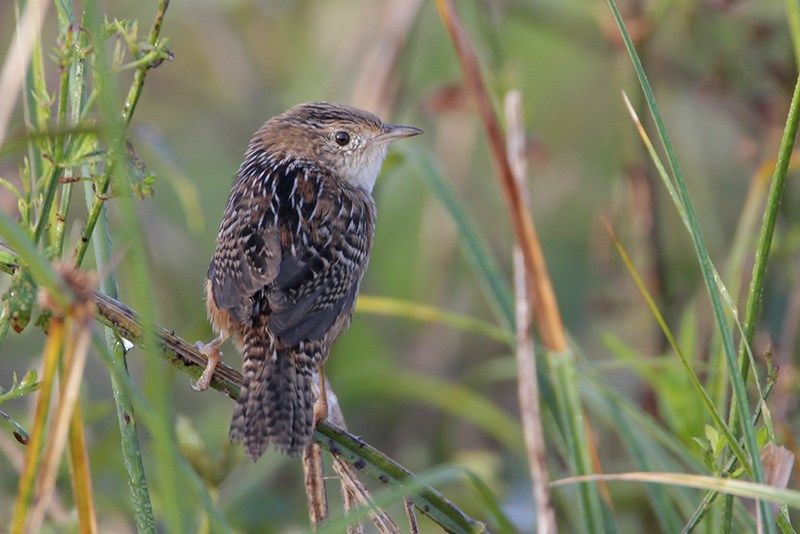Sedge Wren

© Joseph Kennedy
Cistothorus stellaris
Family: (Troglodytidae) Wrens
Preferred Habitat: Sedge and grass marshes
Seasonal Occurrence: Uncommon fall through spring.
Song: Dry staccato chatter which ends in a dry trill.
Notes by Susan Billetdeaux: Sedge Wrens are secretive and difficult to spot in marshes. They are most easily found through their song. Identifying marks: small, short, thin bill, indistinct white eye stripe, very short tail. In comparison with Marsh Wrens, they are more uniformly brown; the back stripes are less distinct, the bill is shorter, and white eye stripe less distinct. Marsh Wrens and Sedge Wrens usually do not occur in the same habitat. Sedge Wren populations appear to be in decline because of the species' dependence on sedge marshes which have been greatly reduced in number.
Profile by Sarah Lefoley: Sedge Wrens are small, round, nutmeg-colored birds, with curved bills, inconspicuous eyebrows, finely streaked heads, lighter chests and bellies, and thicker brown and white streaking on the backs, and tails. Their tails are short and are often raised. You are likely to hear them before you see them, due to their secretive behavior.
This wren tends to stay hidden deep within prairies, grassy marshes, and sedge meadows; much to the frustration of birders and photographers alike. When they sense danger, sedge wrens will run away and fly short distances back to the safety of the dense vegetation or sedge meadows to avoid predation.
Sedge wrens forage close to the ground, searching vegetation for insects, such as spiders, ants, grasshoppers, flies, and moths. They will sometimes fly short distances to catch their prey in the air. These wrens build small spherical nests out of grasses and sedges, three feet or less from the ground. Nests are built with the entrance on the side and are lined with soft material, such as fur, plant down, or thin grasses. Sedge wrens will often peck holes into the eggs of neighboring bird's nests, regardless of species.
Sedge wrens breed in the northern parts of the Midwest. They migrate there from their wintering grounds in the southern US and northern Mexico.
Profile by Grace Yaros: Sedge Wrens are small, well-camouflaged wrens. They are brown all over, with a paler throat and belly and dark streaking on the wings, back, and crown. They can be found in wet habitats with dense grasses and sedges, including coastal marshes and wet fields and meadows, where they forage on or near the ground for spiders and insects. They can be rather skulking, and are often heard before they are seen; listen for their sharp “chap!” call to alert you to their presence. They are similar to the closely related Marsh Wren, but can be identified based on habitat and plumage clues: Marsh Wrens are found in wetter habitats, such as cattail marshes, and they lack streaking on the crown and wings.
Sedge Wrens are highly nomadic. Early in the breeding season, individuals breed in the upper-midwestern US and south-central Canada. After this initial nesting period, individuals will spread out into the southern Midwest and into the Northeast. Because of their fairly secretive behavior and tendency to move widely throughout their lives, not much is known about their breeding biology. During the winter, Sedge Wrens can be found from the coastal Mid-Atlantic south through much of the Southeast and along the Gulf Coast, wintering as far south as northern Mexico. Because of their reliance on tall, wet fields, the draining of wetlands reduces the amount of habitat available to these charismatic little wrens. Around the Houston area, Sedge Wrens can be found during the winter months at Bolivar Flats Shorebird Sanctuary, Anahuac National Wildlife Refuge, Brazos Bend State Park, and more!
-
Cornell Lab of Ornithology
-
Bird Guide

© Greg Lavaty, www.texastargetbirds.com

© Greg Lavaty, www.texastargetbirds.com

© Greg Lavaty, www.texastargetbirds.com

© Greg Lavaty, www.texastargetbirds.com




















